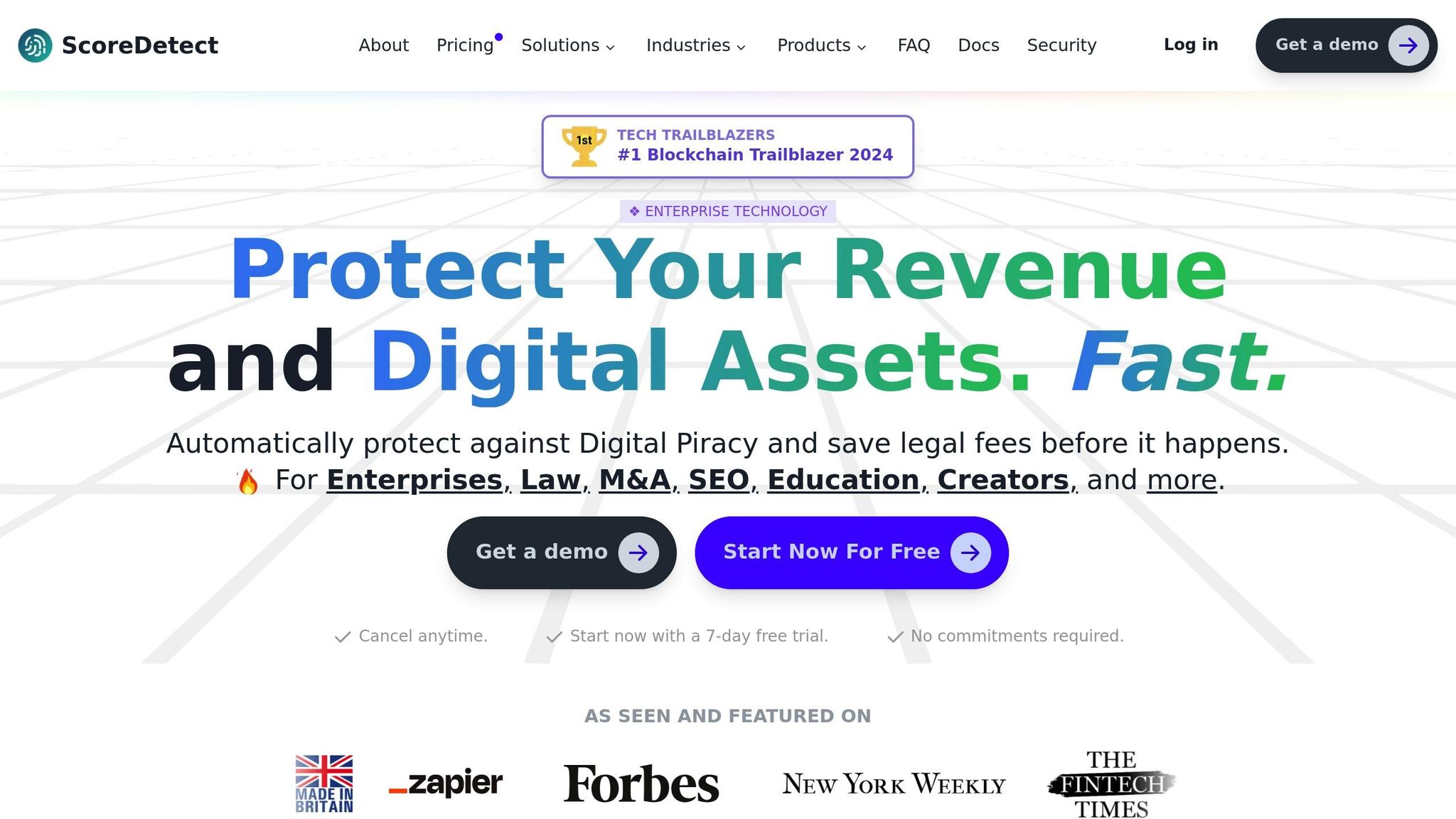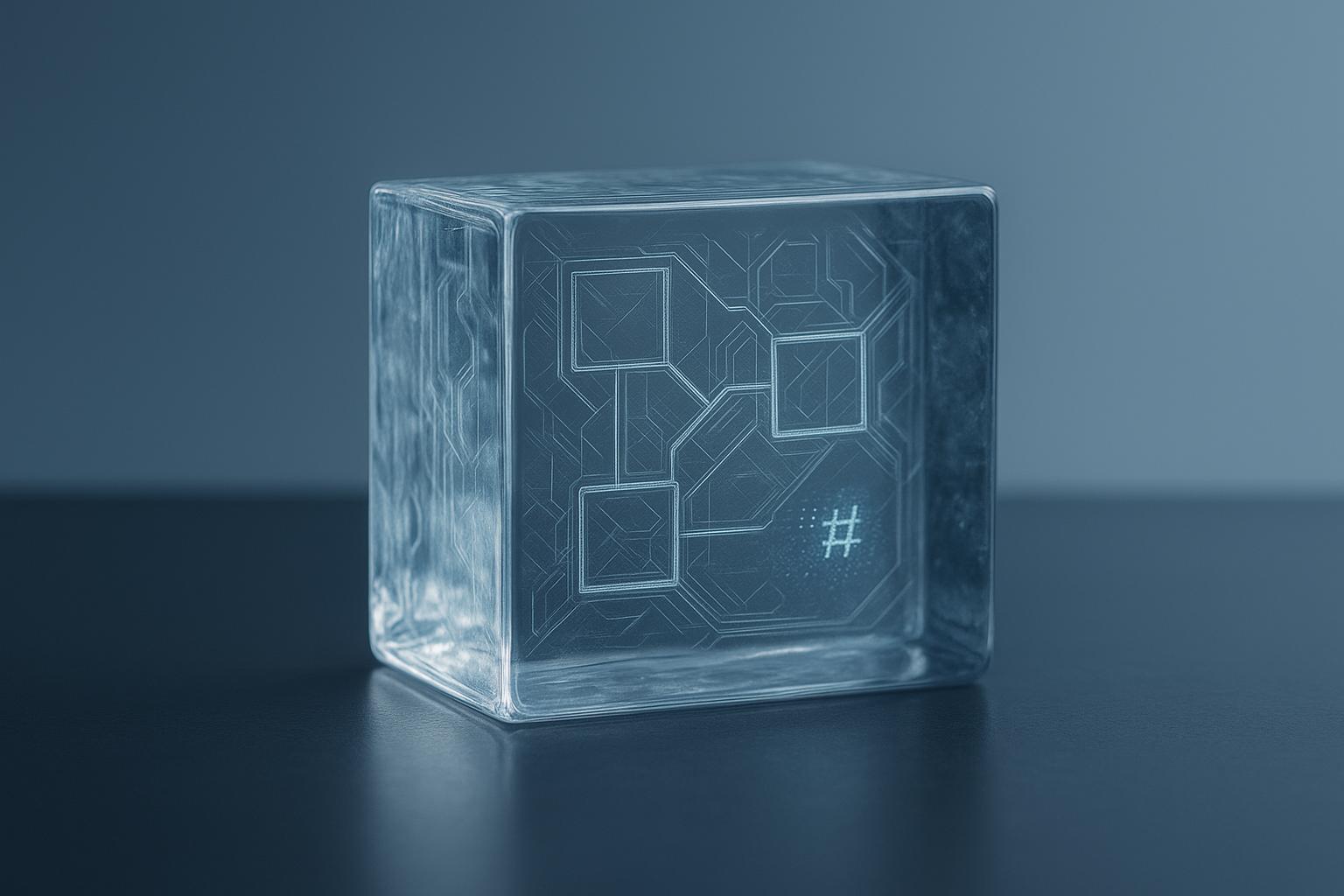Blockchain is transforming copyright protection. By offering secure, tamper-proof records and automated licensing via smart contracts, it addresses challenges like piracy and unauthorized use. Here’s why it matters:
- Global losses: The media industry loses over $50 billion annually to piracy; the music sector faces $12.5 billion in losses.
- Core features: Blockchain ensures ownership with permanent timestamps, decentralized storage, and transparent verification.
- Automation: Smart contracts streamline royalty payments and licensing, reducing delays and middlemen.
- Real-world use: Platforms like Spotify and Ujo Music already use blockchain to manage intellectual property rights efficiently.
While legal and technical hurdles remain, blockchain’s influence is growing, with the market projected to reach $150 billion by 2030. This technology is paving the way for a fairer, more secure digital content ecosystem.
Blockchain: The Future of Intellectual Property Protection | Kary Oberbrunner | TEDxOshkosh
Recent Research on Blockchain Copyright Applications
Recent studies highlight how blockchain is reshaping copyright protection, offering tangible ways to improve the management of intellectual property rights. By leveraging blockchain’s transparency and decentralized nature, researchers have identified measurable advancements in copyright enforcement and management. These findings also hint at potential shifts in legal standards, as explored below.
Key Research Findings
Research underscores blockchain’s ability to enhance copyright protection in several impactful ways. For instance, a study on blockchain-based copyright models revealed that these systems can reduce storage requirements by a factor of 200 while maintaining confidentiality [3]. This efficiency addresses a longstanding challenge in managing large volumes of digital content.
Another key finding is blockchain’s capacity to create reliable audit trails for copyright enforcement. These trails allow copyright holders to identify infringements more efficiently while automating processes like licensing agreements and royalty payments [3]. Compared to traditional methods, these features significantly reduce administrative burdens.
Performance data from recent studies further illustrate blockchain’s practicality. In one example, a decentralized video protection system using IPFS demonstrated impressive metrics: video registration latency averaged 5.02 seconds with a throughput of 409.87, while verification latency clocked in at 4.57 seconds with a throughput of 484.23 [4]. These results confirm that blockchain systems can operate at speeds suitable for real-world use.
Blockchain and US Copyright Law
Beyond technical progress, blockchain is making strides in the legal domain, particularly in copyright enforcement. Legal analyses reveal that courts are increasingly recognizing blockchain as a valid tool for presenting evidence in intellectual property disputes. A review of 54 legal documents across jurisdictions shows that blockchain technology aligns well with existing copyright laws [7].
One notable milestone occurred on January 30, 2025, when the U.S. Copyright Office granted copyright registration to "A Single Piece of American Cheese", a digital artwork created collaboratively by Invoke AI’s CEO Kent Keirsey and artificial intelligence. The registration relied on comprehensive digital documentation, including time-lapse video evidence, which demonstrated human involvement and blockchain-supported proof. This case reflects the growing acceptance of blockchain in copyright registration [5].
US courts are also showing a greater willingness to admit blockchain-based records as evidence in intellectual property cases. Research indicates that courts in both the United States and the United Kingdom are more likely to accept blockchain records when they are presented alongside other legally recognized evidence [7]. However, significant gaps remain. No jurisdiction surveyed has yet established a dedicated statutory framework for blockchain evidence, creating inconsistencies in its application [7].
Despite these challenges, the legal landscape is evolving. The Uniform Law Commission and the American Law Institute recently updated the Uniform Commercial Code to include Article 12, which specifically addresses digital assets [6]. Additionally, an Executive Order from the Biden Administration outlined strategies to manage risks associated with digital assets while encouraging responsible innovation [6].
Successful use of blockchain evidence often hinges on how well it is presented. Proper documentation, jurisdictional considerations, and procedural readiness all play a critical role in court acceptance [7]. While blockchain offers a powerful toolkit for copyright protection, its legal integration requires careful adherence to local standards and meticulous evidence preparation – further reinforcing the technological advancements discussed earlier.
How Blockchain Protects Copyright
To understand how blockchain safeguards copyright, it’s important to delve into the technical mechanisms that make this technology so effective. Blockchain relies on three core components working together to create a robust system for protecting intellectual property. These features not only secure content but also provide practical solutions, as highlighted in the following case study.
Permanent Records and Timestamping
One of blockchain’s standout features is its ability to create permanent, unchangeable records of ownership and content provenance. This addresses major copyright challenges head-on [8]. Unlike traditional digital files, which can be altered or deleted, data recorded on a blockchain is immutable – once it’s written, it stays there [8]. When content is registered, blockchain cryptographically timestamps and permanently stores the data [10]. Each entry is linked to the previous one, so any tampering disrupts the chain’s integrity, making manipulation immediately evident [9][10].
This timestamping capability is particularly useful in legal disputes. The blockchain record serves as undeniable proof of when a piece of content was registered, providing a clear, immutable timeline.
Smart Contracts for Automated Copyright Enforcement
Smart contracts take copyright enforcement to a new level by automating processes that were once manual and time-consuming. These self-executing programs handle licensing, royalty payments, and rights enforcement with efficiency and transparency [11]. For example, smart contracts can instantly calculate and distribute royalties to creators based on predefined terms whenever their content is used [11]. This eliminates delays and reduces reliance on intermediaries like lawyers or licensing agencies.
Platforms like Audius and Opus showcase these capabilities. Artists upload their music with embedded licensing terms, and as listeners stream songs, the smart contracts automatically process and allocate royalties [12]. Additionally, smart contracts are highly adaptable, allowing for complex licensing arrangements. Permissions can be granted automatically once specific conditions are met [11].
Decentralized Storage Integration
By combining blockchain with decentralized storage systems, a highly secure and accessible framework emerges. Decentralized storage spreads files across multiple nodes, removing single points of failure and significantly boosting data security [13]. This is especially critical given the rise in cyberattacks – 71% of which involved stolen credentials in 2023, with 30% using valid accounts [13].
Blockchain further strengthens this system by generating a cryptographic hash when a file is stored. If the file is altered, the hash changes, triggering an alert [13]. At the same time, blockchain tracks where files are stored across nodes, ensuring they can still be accessed even if some nodes fail.
Decentralized storage also offers strong resistance to censorship and ensures data persistence. A great example is The Russian Independent Media Archive (RIMA), which has preserved over six million documents despite government attempts to suppress them [13]. Together, these technical components form the foundation of blockchain’s effectiveness in copyright protection, as demonstrated in real-world cases like ScoreDetect.
sbb-itb-738ac1e
Case Study: ScoreDetect‘s Blockchain Copyright Protection

ScoreDetect combines blockchain technology with AI-driven monitoring to tackle content piracy. As Michael Sumner puts it:
"ScoreDetect exists to provide content protection and brand protection using AI, blockchain and other multiple high technologies" [15].
This approach turns blockchain research into practical tools for safeguarding intellectual property.
How ScoreDetect Protects Content
Instead of storing content directly on the blockchain, ScoreDetect generates verification certificates. These certificates are immutable and unalterable, serving as proof of authenticity. The process is quick, taking just seconds [14]. Each certificate includes the content’s checksum, a blockchain transaction URL, and multiple verification methods [14]. The system uses a "Verification Certificate" smart contract, ensuring that the information it holds can only be created, never altered or deleted [15].
In addition to blockchain verification, ScoreDetect employs invisible watermarks for content tracking. These watermarks are undetectable to users but make it easy to identify and authenticate content across formats like images, videos, audio files, and documents [16]. If unauthorized use is found, ScoreDetect’s automated tools analyze and match the content, providing clear, quantifiable evidence of infringement.
To complement these features, ScoreDetect streamlines protection with automation and platform integration.
Automation and Seamless Integration
ScoreDetect integrates with over 6,000 web applications through Zapier, automating content protection [15]. For example, its WordPress plugin automatically captures published or updated articles, creating blockchain-based proof of ownership. This not only safeguards content but also aligns with Google’s E-E-A-T (Experience, Expertise, Authoritativeness, Trustworthiness) guidelines, enhancing SEO. Users can even timestamp emails, adding another layer of blockchain evidence [15].
Industry Impact and Results
The platform’s technical capabilities translate into real-world results. ScoreDetect boasts a 96% success rate for automated takedown notices. Kyrylo Silin, a SaaS founder and CEO, highlights its benefits:
"With ScoreDetect, I can take pictures for my travel blog and be confident that nobody will claim them as theirs. I can always prove that I am the author" [14].
Joshua Chung, CEO of a startup consultancy, echoes this sentiment:
"As a SaaS company owner, I find ScoreDetect to be a highly valuable tool for ensuring the integrity of our digital content" [14].
ScoreDetect also delivers impressive financial returns. By timestamping content, businesses can boost monthly revenue by $1,000 on top of an existing $10,000, with a net monthly value added of $988 after platform costs [14]. This translates to a potential ROI of +8,233.33% for companies adopting its services [14].
For those hesitant about costs, ScoreDetect offers a 7-day free trial, with Pro plans starting at just $12 per month [14]. Enterprise plans include advanced features like 24/7 monitoring and dedicated support.
Imri, the CEO of a startup SaaS company, sums up the platform’s value:
"ScoreDetect effectively protects intellectual property in today’s digital era, offering innovative, automated solutions" [14].
Challenges and Future Opportunities
While blockchain offers exciting possibilities for copyright protection, its adoption faces hurdles like legal ambiguity and technical barriers. These challenges slow down its widespread use, even though the technology has clear advantages.
Current Adoption Challenges
One of the biggest obstacles is legal uncertainty. Blockchain’s decentralized structure doesn’t always align with existing legal and compliance systems. Courts and regulators are still figuring out how blockchain-based evidence fits within traditional intellectual property (IP) laws, making businesses hesitant to adopt it [1][2].
Another issue is technical complexity. Blockchain isn’t easy for everyone to understand or use effectively. This is especially true for freelancers, artists, and creators in developing regions, who often lack the technical know-how or financial resources to implement blockchain solutions. This leaves many without adequate copyright protection [1].
Interoperability problems also stand in the way. Different blockchain networks often don’t communicate well with each other due to a lack of standardized protocols. This forces businesses to choose between systems, complicating adoption [2].
Additionally, scalability and energy consumption remain major concerns. Blockchain networks often struggle to handle large-scale operations efficiently, and their high energy use raises questions about sustainability.
Finally, enforcement challenges persist. While blockchain can securely record copyright data, it can’t enforce rights in the offline world. For example, it can’t take down infringing content across the internet or address jurisdictional conflicts caused by its borderless nature [1][2].
Despite these obstacles, innovators are working on solutions to make blockchain more accessible and effective for copyright protection.
Future Trends and Developments
Blockchain’s potential for copyright verification is driving efforts to overcome its current limitations. The market is expected to grow significantly, with Gartner predicting blockchain’s business value to reach $176 billion by 2025 and $3.1 trillion by 2030 [17].
One promising area is AI integration and smart contracts. Combining AI with blockchain could allow for real-time monitoring of digital content, helping to detect copyright infringements faster and more accurately [18][19]. Smart contracts can also automate royalty payments, reducing administrative tasks and minimizing disputes [19].
Efforts toward global standardization are also gaining traction. International organizations are working to harmonize blockchain applications for intellectual property management. For instance, the European Union Intellectual Property Office (EUIPO) is exploring ways to use blockchain for recording trademarks and design data, improving transparency and simplifying ownership verification [18]. Companies like Ascribe and Mediachain are showing how blockchain can lower costs and streamline licensing processes [18].
Technical advancements are addressing blockchain’s current drawbacks. Solutions like Layer-2 technologies (e.g., rollups and sidechains) are improving scalability, while energy-efficient consensus mechanisms like Proof of Stake are reducing blockchain’s environmental impact [17]. Cross-chain interoperability protocols are also emerging, making it easier to transfer assets and communicate between different blockchain networks [17].
NFT authentication is set to play a bigger role in trademark protection by 2025. NFTs provide proof of ownership and authenticity for branded items, while decentralized storage solutions enhance the security and accessibility of copyrighted works [20].
Moving forward, collaboration between innovators, lawmakers, and industry leaders will be key. Together, they can create user-friendly blockchain tools, establish global standards, address policy concerns, and bridge the gap between on-chain records and real-world enforcement [1].
Conclusion
Blockchain is reshaping the way copyright protection works, giving creators an unmatched level of control over their digital creations. With features like immutable timestamps, smart contracts, and decentralized verification, blockchain tackles issues that traditional intellectual property systems have struggled to address.
The numbers speak for themselves: annual losses of over $50 billion in media and $12.5 billion in music highlight the pressing need for solutions like blockchain [1]. Meanwhile, more than 1.5 million creative works have already been registered on blockchain platforms, showcasing its value in real-world scenarios [1]. These figures underline the confidence industry leaders have in this technology.
"The blockchain is a shared, programmable, cryptographically secure and therefore trusted ledger which no single user controls and which can be inspected by anyone." – Klaus Schwab, Founder and Executive Chairman of the World Economic Forum [21]
Practical examples, like ScoreDetect, show how blockchain protects content by using checksums and its unchangeable nature to detect plagiarism [1]. By combining AI algorithms with blockchain, the technology addresses concerns from the 52% of creators who feel they lack control over their work [1]. With an expected 60% annual growth rate, blockchain is projected to become a $150 billion industry by 2030, solidifying its place as the future of intellectual property management [1].
While there are still challenges to overcome, the groundwork for a secure, transparent, and creator-focused digital economy is already in place. Blockchain’s impact on copyright protection represents a major shift, empowering creators to safeguard and monetize their work more effectively than ever before.
FAQs
How does blockchain help protect media content from piracy and unauthorized use?
Blockchain technology offers a powerful way to safeguard media content by providing a secure, unchangeable record of ownership and transactions. This allows creators to verify their ownership and monitor the distribution of their work, making it harder for others to engage in illegal copying or sharing.
On top of that, blockchain can integrate with tools like digital watermarking and content monitoring systems to identify and prevent unauthorized use. By promoting transparency and accountability, blockchain has become an essential tool in the fight against piracy and the protection of intellectual property in the media world.
How is blockchain being used for copyright protection, and what are the legal challenges involved?
Blockchain technology is finding a growing role in copyright protection by creating secure, tamper-resistant records of ownership and verifying digital assets. It offers a way to maintain transparency and address issues like unauthorized use of content. However, introducing blockchain records into legal settings presents some hurdles, particularly when it comes to their admissibility and reliability as evidence in court.
Some courts have begun to accept blockchain-based evidence, such as timestamps and digital signatures, but the legal landscape around this is still taking shape. Universal standards for verifying blockchain data and ensuring its dependability are not yet in place, which creates uncertainty about how consistently it will be accepted in legal proceedings. As blockchain continues to gain momentum, it’s expected that laws and policies will evolve to accommodate and support its use more effectively.
How do smart contracts and decentralized storage improve the protection and management of intellectual property rights?
Smart contracts streamline the management of intellectual property (IP) rights by automating processes such as licensing agreements, royalty collection, and ownership tracking. These tasks are executed on secure, tamper-resistant blockchain ledgers, ensuring clarity and minimizing the chances of disputes.
Decentralized storage adds another layer of protection by securely housing ownership records in a way that’s highly resistant to tampering. Together, this blend of automation and secure record-keeping makes handling IP rights both more efficient and dependable.

